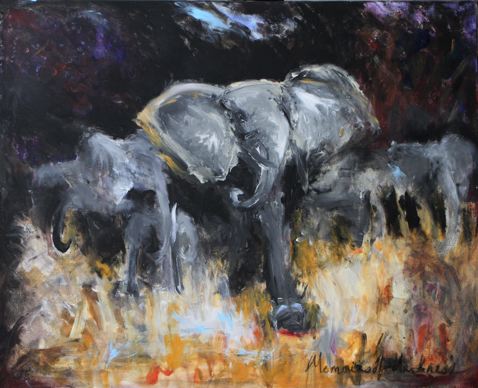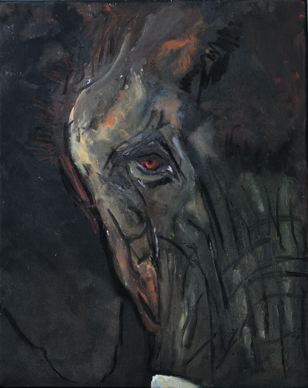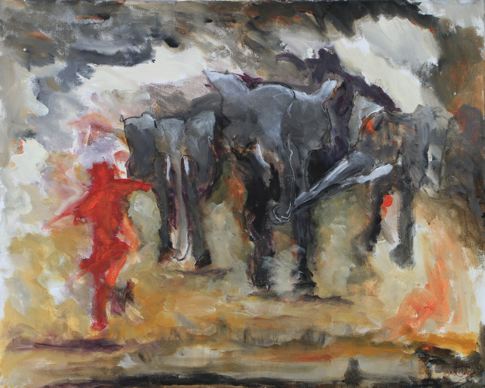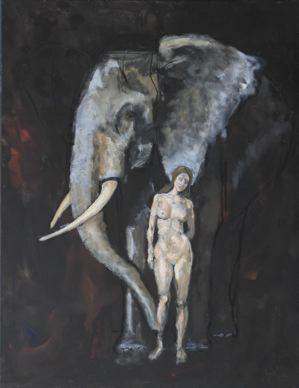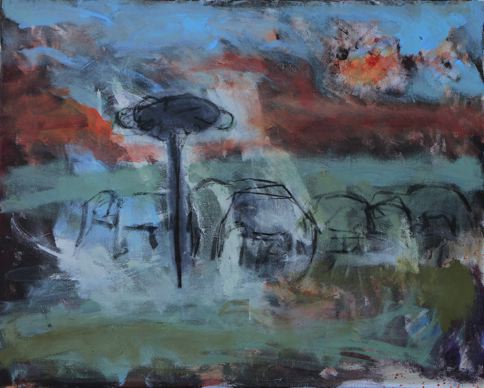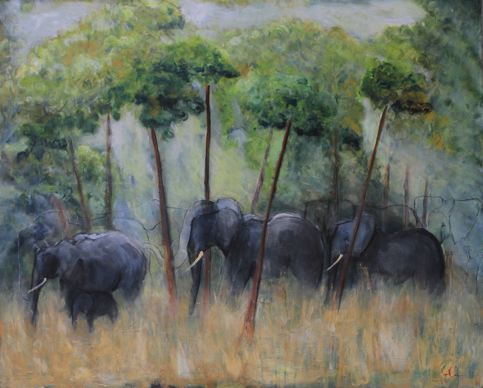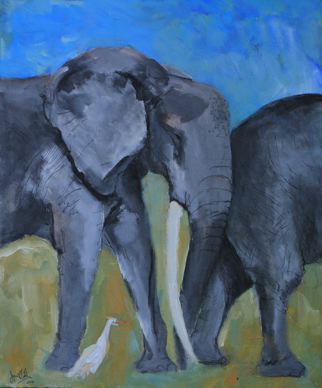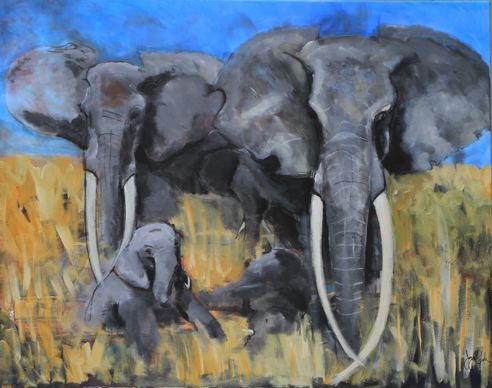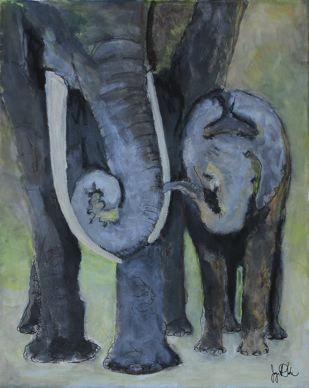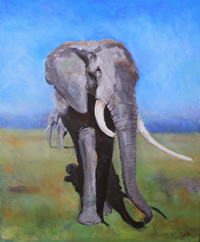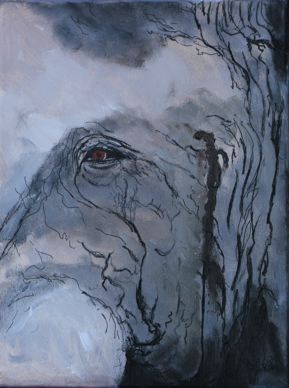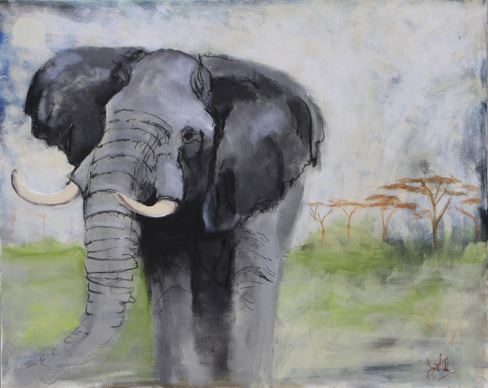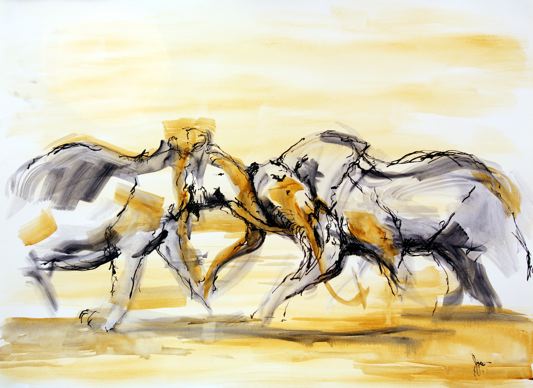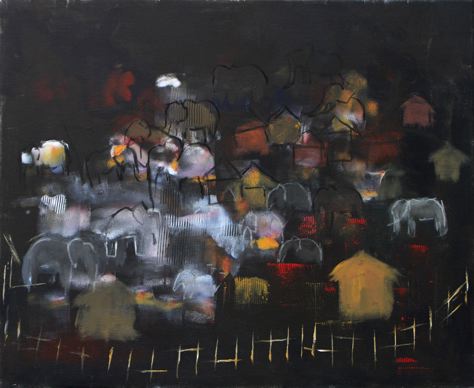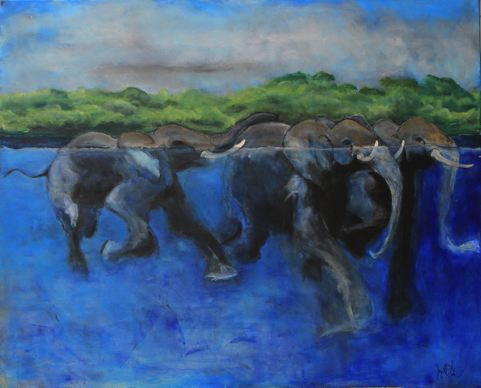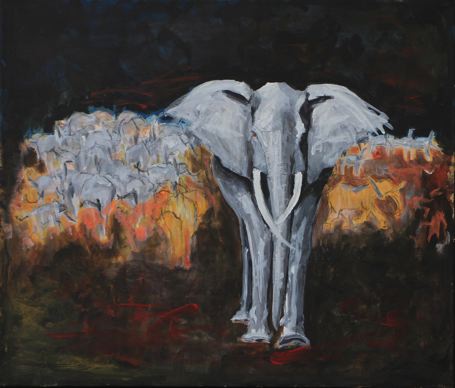Some of my paintings of elephants went on exhibit at Hubro Litteraturhus, Sandefjord, Norway on 31 March 2011 along with a selection of Petter's photographs. Due to a full house we had a second event on 29 April, also with a full house. On both evenings we spoke, through the paintings on Hubro's walls, about the intelligence and sociality of elephants and threats to their survival. By clicking on the images you can see a larger version.
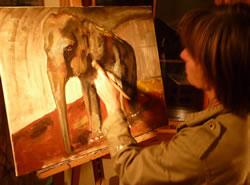 I have enjoyed drawing and painting since I was a young child and I have sweet memories of sketching with my siblings and with my childhood friend, Amanda, at home and on family safaris in Amboseli, the Mara, Tsavo and elsewhere. We had a fancy pullout camping table that became our "studio" after mealtimes. At the Taft School I was fortunate to take drawing and watercolor and oil painting classes with beloved teacher, Mark Potter. And throughout my years as an undergraduate at Smith College, where I studied biological sciences, I took as many studio art classes as I could fit into my schedule.
I have enjoyed drawing and painting since I was a young child and I have sweet memories of sketching with my siblings and with my childhood friend, Amanda, at home and on family safaris in Amboseli, the Mara, Tsavo and elsewhere. We had a fancy pullout camping table that became our "studio" after mealtimes. At the Taft School I was fortunate to take drawing and watercolor and oil painting classes with beloved teacher, Mark Potter. And throughout my years as an undergraduate at Smith College, where I studied biological sciences, I took as many studio art classes as I could fit into my schedule.
Later, I included pen and ink illustrations of elephant behavior in my PhD thesis (34.12 MB) as well as in my memoir, Coming of Age with Elephants. When Petter and I moved to Norway, I began taking intuitive painting classes with local artist, Marit Skyer. Petter created a little studio for me in the house and I have spent many long winter evenings with elephants in Africa through my paintings. The paintings are for sale - get in touch if you are interested. The proceeds go toward our work for elephants.

| Elephant memories and dreams |
|
The Maasai Mara landscape where Petter and I have recently started a new project is characterized by rolling plains punctuated by solitary and elegant Balanites trees. The scenery is so different from that of Amboseli, where I have spent so many years of my life, and I love the image of elephants out on the open grasslands standing by these iconic trees. |
| Individuals and behaviour |
|
TONIE AND BABY (Acrylic, 40cm x 50 cm) I have a special affinity for Tonie because it was through her that I was first given a window into the emotional lives of elephants. Back in 1980 I found her standing out on the open pan in the hot sun with a stillborn infant at her feet. For a long time she struggled to raise the lifeless newborn and then she seemed to understand, and stood listlessly by her dead calf. Her whole body seemed to spell grief. Her head and her ears drooped and the corners of her mouth turned down. Her movements were slow and spiritless, except when she was called to defend her calf from predators. When on the next day I found her still standing vigil over her dead calf, I decided to take some water to her. I filled two 20-liter jerry cans and took with me a large plastic basin. Parking my car nearby, I set the basin on the ground and began to pour. As she heard the water splash into the basin she came eagerly to my side and began to drink as I poured, her tusks just centimeters from my head. After she had quenched her thirst she reached into my car and touched me gently on my chest. Then she went back to her vigil. This painting of Tonie and baby is inspired by a recent photograph taken by our friend and elephant sculptor, Doug Aja. |
|
Males in musth carry themselves with a very characteristic swagger, known as the Musth Walk - holding their heads high, their jaw tucked in and their ears stiff and slightly extended. This posture makes them appear even larger and more impressive than they are! When confronted by another male of equal stature a musth male will draw himself up to his full height and spread his ears in threat as in this painting, after a photograph by Doug Aja. |
| Elephant conservation and welfare |
|
FREE SPIRITS (Acrylic, 40cm x 120cm) Free Spirits is inspired by a series of photographs taken by Petter of a family of elephants at play and has become the banner for The Elephant Charter. The Elephant Charter, which Petter and I wrote together with four other elephant biologists represents a consensus of the nature of elephants and was written to provide a set of guiding Principles as a touchstone for anyone needing to address elephant interests. The Charter is intended to promote scientifically sound and ethical management and care of all elephants, providing guidance to law and policy makers, enforcement agencies and the courts, organizations, institutions and international bodies, as well as to managers of wild and captive elephants. Please join us by signing the Elephant Charter. |



